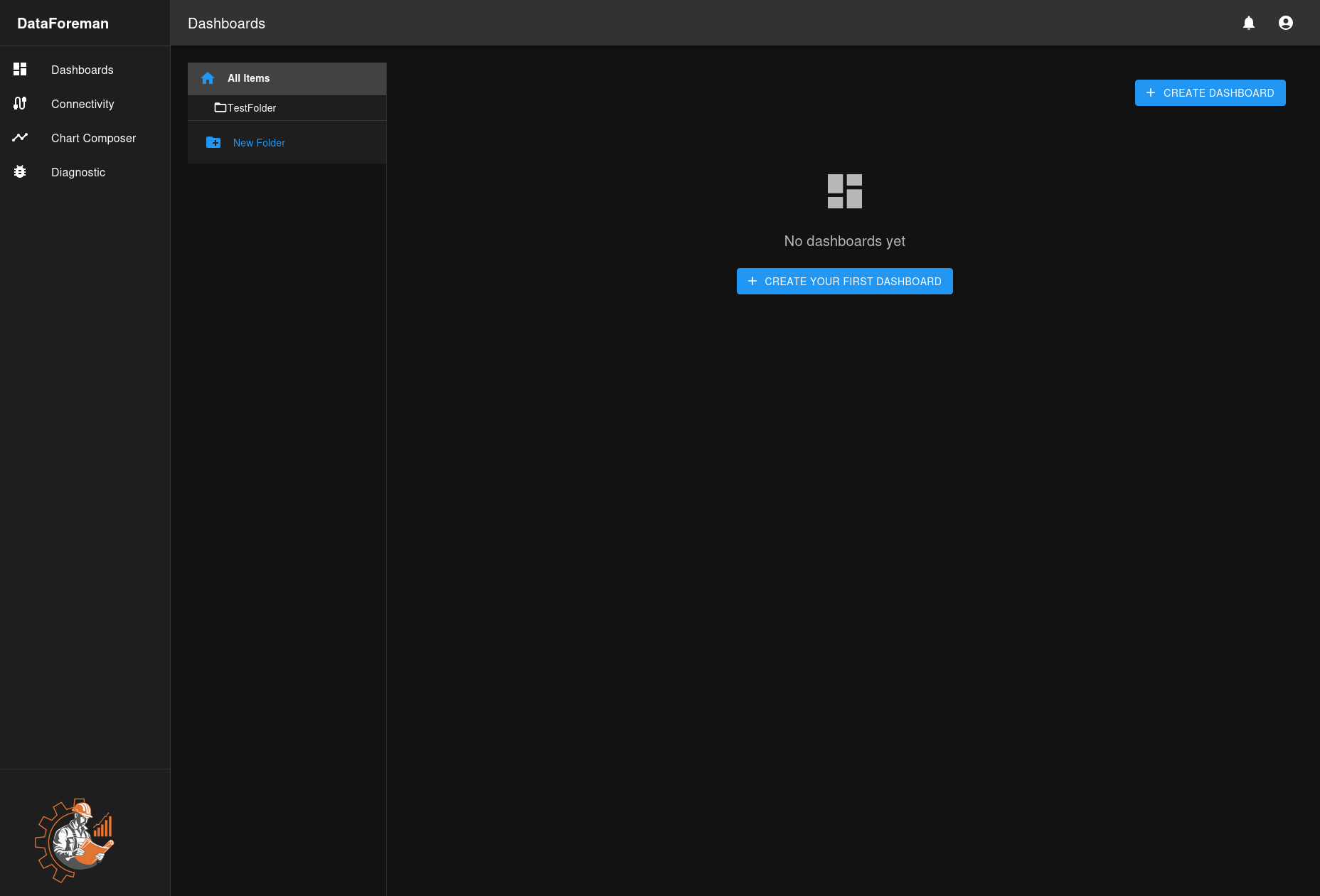Dashboard Creation & Management
Dashboards in DataForeman provide a customizable interface for visualizing real-time and historical data from your industrial devices. Organize your visualizations into folders and create as many dashboards as you need.

Overview
Dashboards allow you to:
- Create custom layouts with multiple charts and widgets
- Organize dashboards into folders for better management
- View real-time and historical data side-by-side
- Share dashboards with team members (based on permissions)
- Export dashboard data for reporting
Creating Your First Dashboard
Step 1: Navigate to Dashboards
Click the Dashboards icon in the left sidebar to access the dashboard management interface.
Step 2: Create a New Dashboard
- Click the CREATE DASHBOARD button in the top-right corner
- Enter a dashboard name and description
- Optionally, select a parent folder to organize your dashboard
- Click Create to save
Step 3: Add Charts to Your Dashboard
Once your dashboard is created:
- Click Add Widget or Add Chart
- Select from existing saved charts in Chart Composer
- Arrange charts using drag-and-drop
- Resize charts by dragging their corners
- Click Save to preserve your layout
Organizing with Folders
Creating Folders
- Click New Folder in the left panel
- Enter a folder name
- Optionally, select a parent folder for nested organization
- Click Create
Managing Folders
- Create Subfolder: Hover over a folder and click the subfolder icon
- Edit Folder: Click the pencil icon to rename
- Delete Folder: Click the trash icon (dashboards inside will be moved to parent or root)
Dashboard Features
View Mode
In view mode, dashboards display your data cleanly without editing controls:
- Charts update automatically based on configured refresh rates
- Click any chart to view details or drill down
- Use the time range selector to adjust the viewing window
- Toggle between dark and light themes
Edit Mode
Edit mode allows you to customize your dashboard layout:
- Drag charts to reposition them
- Resize charts by dragging corners
- Add new charts from your saved collection
- Remove charts you no longer need
- Configure chart-specific settings
Sharing & Permissions
Dashboards respect the DataForeman permission system:
- Users need read permission to view dashboards
- Users need update permission to edit dashboards
- Users need create permission to make new dashboards
- Administrators can control access through User Management
Tips & Best Practices
-
Organize Strategically: Use folders to group dashboards by:
- Production line or area
- Equipment type
- Shift or department
- Process stage
-
Optimize Performance:
- Limit dashboards to 6-8 charts for best performance
- Use appropriate time ranges to reduce data load
- Consider separate dashboards for real-time vs historical views
-
Naming Conventions: Use clear, descriptive names like:
- “Line 1 - Production Overview”
- “Boiler System - Real-Time”
- “Quality Metrics - Daily”
-
Regular Cleanup: Archive or delete unused dashboards to keep the interface manageable
Troubleshooting
Dashboard Won’t Load
- Check Permissions: Ensure you have read access to the dashboard
- Verify Charts: Make sure all charts in the dashboard still exist
- Check Data Source: Confirm the devices are connected and sending data
Charts Not Updating
- Refresh Rate: Check if auto-refresh is enabled
- Data Availability: Verify data exists for the selected time range
- Browser Console: Check for JavaScript errors (F12)
Layout Issues
- Clear Cache: Try refreshing the page (Ctrl+F5 or Cmd+Shift+R)
- Browser Compatibility: Use a modern browser (Chrome, Firefox, Edge)
- Screen Resolution: Some layouts may need adjustment for different screen sizes
Keyboard Shortcuts
- Ctrl+S / Cmd+S: Save dashboard (in edit mode)
- Esc: Exit edit mode
- F11: Toggle fullscreen mode
- R: Refresh all charts
Next Steps
- Learn how to create charts in the Chart Composer
- Connect devices in Device Connectivity
- Manage user access in Permission System
